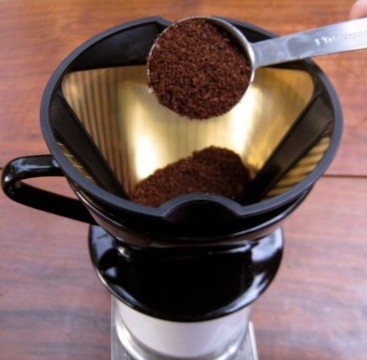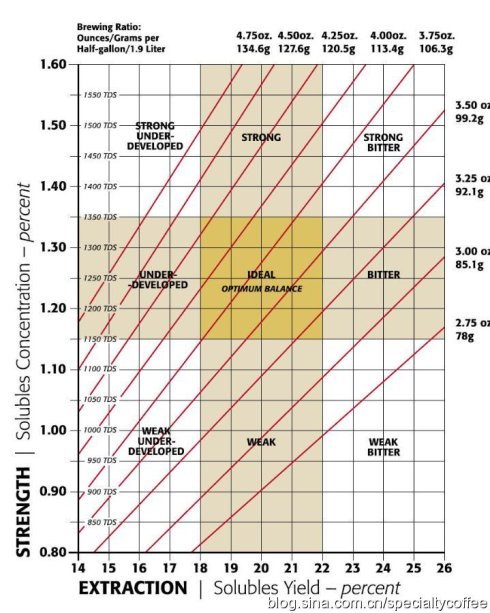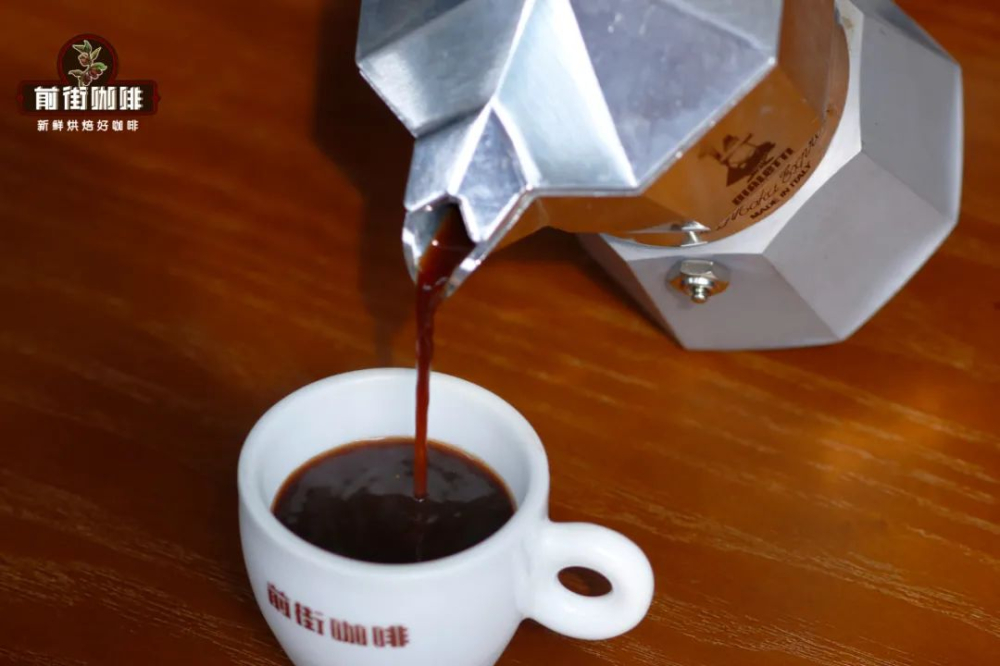The ratio of coffee to water

(source: google)
Standard brewing ratio (Standard Brewing Ratio)
Coffee cup count
The amount of coffee used COFFEE TO BE USED
Water consumption WATER TO BE USED
Cups of Coffee
By weight
Meter by measuring tool
BY WEIGHT
BY MEASURE
Ounce Ounces
Gram Grams
Teaspoon Tea
Spoon Table
Cup Cups
Coffee liquid (oz)
Number of cups Cups
Pint Pints
Quart Quarts
One GAL, two gallons, two gallons.
Ml CCs (milliliters)
L Liters
Spoons
Spoons
Fluid
Ounces
1
0.38
11
6
2
January 8th
8
1
January second
January fourth
January 8th
237
0.2
2
0.75
21
12
4
January fourth
16
2
1
January second
January fourth
473
0.5
3
1.13
32
18
6
March 8th
24
3
1 1/2
March fourth
March 8th
710
0.7
4
1.5
43
24
8
January second
32
4
2
1
January second
947
1
5
1.88
53
30
10
May 8th
40
5
2 1/2
1 1/4
May 8th
1183
1.2
6
2.25
64
36
12
March fourth
48
6
3
1 1/2
March fourth
1420
1.4
7
2.63
74
42
14
July 8th
56
7
3 1/2
1 3/4
July 8th
1656
1.7
8
3
85
48
16
1
64
8
4
2
1
1893
1.9
9
3.38
96
54
18
1 1/8
72
9
4 1/2
2 1/4
1 1/8
2130
2.1
10
3.75
106
60
20
1 1/4
80
10
5
2 1/2
1 1/4
2366
2.4
11
4.13
117
66
22
1 3/8
88
11
5 1/2
2 3/4
1 3/8
2603
2.6
12
4.5
128
72
24
1 1/2
96
12
6
3
1 1/2
2840
2.8
If you know the amount of coffee powder, multiplied by the coefficient 21.33, you know how many ounces of water you need (0.046875 is the inverse coefficient), multiplied by the coefficient 22.2593, you get how many milliliters of water you need (0.04493 is the inverse coefficient).
For example, if you have 1.2oz coffee powder, multiply it by 21.33g, you will need 25.6oz water; 92.6g coffee powder will need 2061CCs water. The amount of coffee powder required can be obtained by multiplying the inverse coefficient with the known amount of water.
The brewing ratio of enthusiasts Connoisseur's Brewing Ratio
Cups of Coffee
The amount of coffee used COFFEE TO BE USED
Water consumption WATER TO BE USED
BY WEIGHT
BY MEASURE
Ounces
Grams
Tea
Table
Cups
Fluid
Cups
Pints
Quarts
1/2 Gal
CCs
Liters
Spoons
Spoons
Ounces
(milliliters)
1
0.38
10.6
6
2
January 8th
6
March fourth
March 8th
March sixteenth
3/32
177
0.18
2
0.75
21.3
12
4
January fourth
12
1 1/2
March fourth
March 8th
March sixteenth
three hundred and fifty five
0.35
three
1.13
31.9
eighteen
six
March 8th
eighteen
2 1/4
1 1/8
September sixteenth
9/32
five hundred and thirty two
0.53
four
1.5
42.5
twenty-four
eight
January second
twenty-four
three
1 1/2
March fourth
March 8th
seven hundred and ten
0.71
five
1.88
53.2
thirty
ten
May 8th
thirty
3 3/4
1 7/8
15/16
15/32
eight hundred and eighty seven
0.89
six
2.25
63.8
thirty-six
twelve
March fourth
thirty-six
4 1/2
2 1/4
1 1/8
September sixteenth
1065
1.06
seven
2.63
74.4
forty-two
fourteen
July 8th
forty-two
5 1/4
2 5/8
1 5/16
21/32
1242
1.24
eight
three
85.1
forty-eight
sixteen
one
forty-eight
six
three
1 1/2
March fourth
1420
1.42
nine
3.38
95.7
fifty-four
eighteen
1 1/8
fifty-four
6 3/4
3 3/8
1 11/16
27/32
1597
1.6
ten
3.75
one hundred and six
sixty
twenty
1 1/4
sixty
7 1/2
3 3/4
1 7/8
15/16
1775
1.77
eleven
4.13
one hundred and seventeen
sixty-six
twenty-two
1 3/8
sixty-six
8 1/4
4 1/8
2 1/16
1 1/32
1952
1.95
twelve
4.5
one hundred and twenty eight
seventy-two
twenty-four
1 1/2
seventy-two
nine
4 1/2
2 1/4
1 1/8
2130
2.13
If you know the amount of coffee powder, times the coefficient 16, you know how many ounces of water you need (0.0625 is the inverse coefficient), multiplied by the coefficient 16.6945, you get how many milliliters of water you need (0.04493 is the inverse coefficient).
For example, if you have 1.2oz coffee powder multiplied by 16.0, you need 19.2oz water; 92.6g coffee powder requires 1562CCs (1.56L) water. The amount of coffee powder required can be obtained by multiplying the inverse coefficient with the known amount of water.
Comparing the two tables, it is not difficult to find that the so-called brewing of enthusiasts is just a little higher in concentration and heavier in taste. Simple and simple words: one serving of powder, about 16 parts of water.
The picture below is the coffee brewing rate chart of SCAA, which looks a little confused.

(source: scaa.org)
Important Notice :
前街咖啡 FrontStreet Coffee has moved to new addredd:
FrontStreet Coffee Address: 315,Donghua East Road,GuangZhou
Tel:020 38364473
- Prev

Using mocha pot to make espresso process methods, steps and skills of mocha pot brewing coffee
In a way, the coffee made by the mocha pot is the predecessor of today's espresso, because although the mocha pot is not a machine, it is also extracted by pressure. The water in the lower pot is in an airtight space, evaporating to form pressure, squeezing hot water into the upper pot and extracting the coffee, so the coffee is rich in flavor, but by
- Next

Espresso Al's Rule
Al Critzer's understanding of Espresso extraction has now become the most common Espresso concept in Europe and America. Take the result of 30cc/ 30sec to get a perfect cup of Espresso as the starting point. These two values depend on the beans, of course, and differences in baking methods, baking degrees, and recipe proportions naturally lead to changes in the reference point. Extraction quantity and extraction time mutually interact
Related
- Beginners will see the "Coffee pull flower" guide!
- What is the difference between ice blog purified milk and ordinary milk coffee?
- Why is the Philippines the largest producer of crops in Liberia?
- For coffee extraction, should the fine powder be retained?
- How does extracted espresso fill pressed powder? How much strength does it take to press the powder?
- How to make jasmine cold extract coffee? Is the jasmine + latte good?
- Will this little toy really make the coffee taste better? How does Lily Drip affect coffee extraction?
- Will the action of slapping the filter cup also affect coffee extraction?
- What's the difference between powder-to-water ratio and powder-to-liquid ratio?
- What is the Ethiopian local species? What does it have to do with Heirloom native species?

